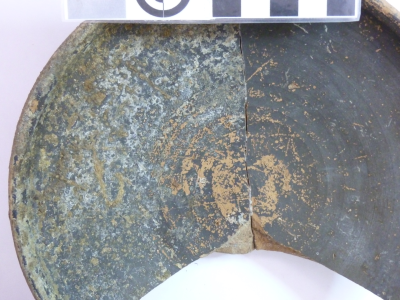
Cite this as: Banducci, L.M., Opitz, R. and Mogetta, M. 2018 Measuring Usewear on Black Gloss Pottery from Rome through 3D Surface Analysis, Internet Archaeology 50. https://doi.org/10.11141/ia.50.12
In January 2016, the CaLC-Rome: Capturing the Life Cycle of Ceramics in Rome project was launched to begin a campaign of high-resolution digital recording of Roman black gloss vessels from central Rome. This project carries on from the Hidden Treasure of Rome project, a loan of 249 largely complete vessels from a little-known storehouse in Rome to the University of Missouri, Columbia, which was the result of an agreement unprecedented in the United States. The purpose of the original loan was to facilitate the study of the vessels' morphology and chemical composition, and was sponsored by the Sovrintendente Capitolino, Claudio Parisi Presicce, and funded by Enel Green Power, an Italian-American energy company (Barker 2014). The aim of CaLC-Rome, a new phase of study, is to examine in detail the minute traces of production and use of these vessels and to produce a digital record of their form. Thus, a campaign of high-resolution, high-precision 2D and 3D data capture was undertaken. In addition to the authors of this article, this digital recording has involved the collaboration of several researchers from the University of Arkansas and the Université Bourgogne Franche-Comté, in France, whose work is gratefully acknowledged.
Following the unification of Italy in 1871, downtown Rome underwent rapid development with the construction of new government buildings. Rescue excavations for this building programme during the late nineteenth and early twentieth century recovered a large quantity of archaeological material that was quickly excavated. Initially the bulk of the finds was stored in temporary depositories across the city. A new exhibition wing was built in the early 1870s in the Palazzo dei Conservatori for artefacts that could be displayed, but more materials were unearthed.
Construction of a Magazzino Archeologico Comunale was completed in 1890 on the Caelian hill to store and display the excavated materials. Rodolfo Lanciani conceived it as an urban museum where the archaeological material would be organised both chronologically and topographically to provide a picture of the development of the city of Rome. The initial plan was soon abandoned, due in part to conflicts with the state archaeological service (Arata and Balistreri 2011, 270-71). The final building, which was opened to the public in 1894, was much smaller than anticipated, and given a less pretentious title. Renamed the Antiquarium in 1900, the complex was reorganised in 1925-1928 and materials were arranged according to major media – such as glass, bronze, or pottery. Where possible, objects that could be associated with a specific monument or defined area, particularly in the case of deposits and funerary assemblages, were kept together (Muñoz 1929, 566). Ceramic vessels were on display by class in the Sala V, together with anatomical votives (Colini 1929, 37-42).
Structural damage to the Antiquarium museum during construction of the subway linking Rome's main train station with the new neighbourhood caused the sudden abandonment of the complex in 1939. The bulk of the artefacts were transferred over the years to temporary storage facilities (Mura Sommella 1992; Arata and Balistreri 2011, 275-79).
While we have no documentation of specific excavation context for any of the 249 black gloss objects that were loaned to the University of Missouri, Columbia (MU), at least three pots came with small scraps of paper indicating that they were from the Esquiline. Furthermore, 40 vessels from the sample currently at MU were published in the catalogue of the 1973 Roma medio repubblicana exhibition (Taloni 1977, 209-21, 226-33; Boyer 2015, 41). Drawings of four of these objects were also included by J-P. Morel in his typology of black gloss pottery (Morel 1981, F1111c1, F3681a1, F4253c1, F8241b1). Eight of the published objects have a provenance listed as a specific tomb, city-block or street (the others being generically assigned a provenance from the Esquiline necropolis). In five cases some information on the tomb type (primarily featuring a stone case, either a monolithic sarcophagus or a 'cassa' made of individual slabs) and on the grave-goods assemblage is also preserved in the excavation reports of the necropolis (Pinza 1905: tomb LVI; Pinza 1914: tombs 3, 105, 106, 127).
Black gloss pottery is well known from sites of the Republican period in Italy and the Western provinces. Its morphological study, starting with Nino Lamboglia and the foundational work of Jean-Paul Morel, continues to be nuanced following the systematic excavation and publication of sites throughout Italy (Di Giuseppe 2012; Stanco 2009; Ferrandes 2006; 2008). The application of sophisticated archaeometric techniques is also helping to broaden our understanding of the locations and methods of manufacture of these vessels (Mirti et al. 1998; Mirti and Davit 2001; Olcese 2013; Peña and Gallimore 2014). Discussions about the function and use of black gloss vessels in Greek and Roman households have centred first around their status within the hierarchy of metal, glass, and ceramic vessels and the meaning and intention of skeuomorphism more generally (Vickers 1989; Morel 1979). The shapes and shiny iridescent surface of these vessels suggest that they were produced, at least originally, to be a more affordable alternative to vessels made of silver or bronze. But the production quality of black gloss vessels varies significantly, probably owing to the different locations of production. Some vessels have much thicker, consistent slip that is more carefully applied; some vessels have very friable and rather coarse interior fabric. This may indicate that within this one class of pottery, there were different qualities of goods acquired by customers of differing wealth (Roth 2007). Secondly, the morphological study of black gloss assemblages has also suggested that we can see changes in food practices both in terms of diet and dining behaviours. Jordi Principal noted the change in shape and size of black gloss vessels in third and second century BCE Iberia that reveals a shift both in the artistic inspiration for these vessels and in the consumption of semi-liquid stewed foods versus flat, drier foods (Principal 2006). Benjamin Luley has also noted that the shift from black gloss vessels to terra sigillata vessels dominating domestic assemblages at Lattara, France, betrays a shift in communal dining practices (Luley 2014; see also this volume).
In contrast, the ways in which the functions and use of black gloss pottery may vary within specifically non-domestic contexts has not been previously examined. Furthermore, the study of black gloss vessel forms is not typically combined with the examination of wear that may suggest how these vessels were used. While usewear analysis is a developing field of archaeology, the analysis of ceramic vessels is unusual. Observations of usewear on ceramics have noted that vessels of different shapes and decoration often have different patterns of wear, such as abrasion patches or scratches from various types of tools for stirring and scooping, confirming the fact that they were used differently (Griffiths 1978; Biddulph 2008). For example, black gloss bowls excavated in Musarna, Italy, display concentric scratches from stirring, while plates at the same site tend to have straighter scratches, probably from cutting (Banducci 2014) (Figure 1).

Assessing wear on complete or largely complete vessels is ideal, since we can understand the wear in the context of the whole object and can be confident that the object has undergone minimal post-depositional disturbance after it was discarded. That is, the wear we observe is more likely a result of human use rather than natural processes of fragmentation or erosion after burial (Bray 1982, 136; Hally 1983, 3; Skibo 1992, 45; Skibo 2013). Unfortunately, the circumstances in which archaeologists excavate whole vessels – primarily tomb and ritual contexts – are limited.
The set of vessels from the Capitoline Museums provides an unparalleled opportunity to study a large sample of black gloss vessels, many of which are complete or nearly complete. The research questions of the project focus firstly on developing protocols for analysing ceramic wear using digital applications – tackling the challenges of recording fine surface variations, distinguishing between wear from production, use, and post-depositional processes, and the metric characterisation of these surface traces.
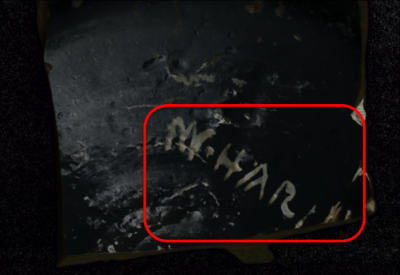
The 3D data were captured using two different scanners, allowing us to experiment with four different resolutions. We used a Breuckman Smartscan-HE white-light scanner, which is commonly used for archaeological applications, and a GOM Atos triple-scan, which was originally designed for the automotive and aerospace industry, and is likewise now employed in the heritage sector. It uses a blue light and thus successfully captures data on dark and shiny surfaces, like the black gloss vessels, which are problematic for both laser and traditional fringe projection scanners (see Opitz 2013; Opitz and Limp 2015). Following a comparison of data captured with two sets of lenses on each scanner, the team determined that the data produced by the GOM with the Core 80 scanning head was best suited to the needs of this project, on the basis of the visual clarity and measurability of traces of wear. The resolution and clarity is illustrated by a comparison of a high-resolution 2D colour photograph with a still of the 3D image at 70 microns. In the photograph (Figure 2) we can see the four letters (an abbreviated name M. HAR) painted in white slip on the surface of the black vessel. In the 3D scan (with pink shading here for visibility), one can make out the elevation of these letters, despite the fact that they have only been applied with slip (Figure 3).
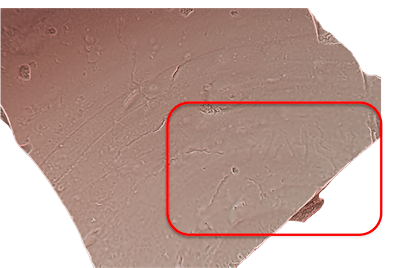
The preliminary results of our study suggest that high-resolution scans can be used successfully to identify traces that are not visible to the naked eye, notably to determine the sequence of overlapping abrasions. This is consistent with the results of similar projects (Grosman et al. 2011). Zooming in to the surface of the vessel allows us to examine individual traces of wear greatly magnified (Figure 4 and Figure 5). The extremely detailed mesh data also provides an opportunity for metric analysis of the surface characteristics in order to quantify the extent and depth of wear, and potentially to develop 'fingerprints' for different types of wear. We can measure the length and depth of these scratches to a high level of accuracy, as well as characterising the shape of their profiles. The close examination of cut profiles has been undertaken by zooarchaeologists examining animal bones, when trying to understand what types of tools were used by ancient butchers and cooks (e.g. Bello and Soligo 2008; Bello 2011). The methodological experiments carried out in this project are being used to develop a set of procedures that could be applicable to the study of other Roman tablewares.
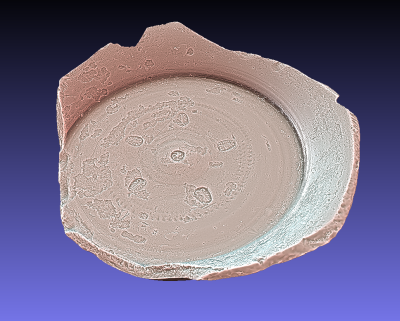
The large sample and general context of these tablewares allows us to consider how information about their use contributes to our understanding of artefacts in the funerary and sanctuary landscape of the city of Rome. Although we do not know the exact provenance of all the vessels, beyond those that can be linked to the Esquiline necropolis, their complete condition strongly suggests that the remainder were also either deposited as grave goods in tombs or given as offerings at a religious site in Rome. Thus the Capitoline collection also allows for the detailed study of an unusually large number of vessels from 'high intentionality' deposits in the city. We are specifically interested therefore in how better information about vessel use can contribute to our understanding of how the purchasing and deposition of artefacts in these ritual circumstances worked in the Roman world. Although we know the broad outlines of Roman burial practices (the preparation of the body, the procession, the feasting in certain circumstances), ancient literary sources tell us nothing about where and how the accoutrements for the funeral were acquired. Did you deposit in the tomb 'grandmother's china' or did you deposit newly purchased vessels?
When we turn specifically to sanctuary offerings, we know little about the origins of dedicated offerings. The recent material turn in the study of Roman religion includes the role sacrifice and ritual played in the wider economy. Votive offerings are beginning to be integrated into the discussion here, yet the material qualities of these objects and their use-life are rarely engaged with (though see Draycott and Graham 2017; Osborne 2004; Bouma 2001; Smith 2001).
The majority of the vessels in our dataset show some evidence of wear before they were deposited, suggesting that vessels from a domestic or other context were the norm. We are still examining what patterns might be discernable in this wear that may convey some consistency of use. Some vessels show a particular type of limited wear: they have wear on their exterior base indicating that they may have been dragged across a table, but their rim and interior has no other abrasion. This might suggest that these vessels were considered precious and were kept for display, but had limited use before deposition. Alternatively, such wear may simply be the result of the handling or display of these vessels after they were excavated.
Before the launch of the CaLC-Rome Project, archaeologists at MU had already begun a campaign of 2D data capture using Reflectance Transformative Imaging (RTI) using a specially constructed dome with 82 LED lights (Figure 6). The purpose of this project was to create high-resolution images of the interior stamps on the black gloss vessels. This allows for the detailed study of the stamp dies and further refinement of our understanding of the organisation of the workshops of vessels commonly called 'petites estampilles' (Stanco 2009; Morel 1969).
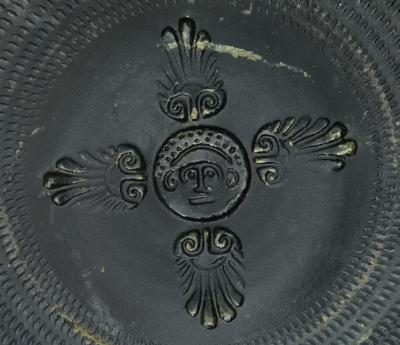
Continuing this interest in exploring vessel production, 3D scanning records the morphology of the vessels with high metrical accuracy as well as the fine surface traces of production. Three-dimensional digital models of the whole form of the vessel allows for the study of vessel symmetry and standardisation, with clear implications for our understanding of vessel building through coils and on the wheel as well as the potter's skill and workshop productivity. Scans also produce a high-quality permanent record of potters' fingerprints remaining in both the clay and the black gloss slip.
An archive of the data collected through the CaLC-Rome Project including the scan data, images, and metadata has been created and is available through the University of South Florida Library digital archives.
In the current phase of our research we are developing new approaches to taking measurements and creating descriptions of these traces of abrasion. The methods for taking individual measurements on scratches, shallow abrasions, and other traces of wear are simultaneously simple and well known, and poorly defined and the subject of some debate. Many 3D software packages, including the open source Meshlab (Cignoni et al. 2008) and CloudCompare (CloudCompare 2016), and the free Sketchfab online viewer (Sketchfab 2017), GOM Inspect (GOM Inspect 2013), and Geomagic Verify Viewer (Geomagic 2017) include tools for taking linear and angular measurements of varying complexity. Measurements such as the depth of a scratch, the angle from its top rim to the centreline of the base, or the ratio of the width at the top and bottom can all easily be taken. However, which of these measurements is useful for distinguishing between classes of wear remains debatable. Visual inspection, typically of an anecdotal rather than statistically rigorous nature, has dominated usewear studies of ceramics (e.g. Griffiths 1978) and systematic studies that develop clearly defined sets of criteria are rare, particularly within classical archaeology.
Using the digital models of the black gloss vessels produced for this project, we are developing three inter-related approaches to quantitatively characterise and distinguish different types of wear, a crucial step to differentiating clearly between production, use and post-depositional abrasion. The first approach is based on the multivariate characterisation of individual traces of wear identified visually on the vessels. For the initial phase of work, we have chosen to focus on linear and curvilinear narrow gauge scratches. Control areas without abrasions are sampled in parallel with areas with recognised abrasions. Patches of the 3D model with or without scratches are projected as a 2.5D surface, that is a mostly flat surface with some topography, analogous to a Digital Surface Model, and morphological indices, e.g. profile curvature, openness of the interior of scratches, and tangential curvature are calculated. From here we may calculate simple descriptive summary statistics for each index, and carry out the multivariate comparison between scratch and control samples. Alternatively, we can attempt to account for the spatial distributions of the indexes, for example by calculating the patchiness of each index, and then undertaking the multivariate comparison of those metrics.
Visual inspection and interim results suggest, unsurprisingly, that within each scratch and within the category of scratches there is a degree of variability that makes quantitative, morphological description difficult. This is a common problem with the recognition of irregular forms. Acknowledging that we have encountered the traditional problems with attempting to characterise phenomena such as different types of wear that have a large degree of variation within each type, and a degree of overlap between types, using a set of indicators (the multivariate statistical descriptor approach described above), our second approach takes advantage of recent developments in machine learning and image recognition. For the initial phase of development of this approach, we created a set of training data (n>200 samples) for the profile curvature metric calculated for linear scratches and control areas. We created a custom collection on Indico's Image Analysis platform (Indico 2017), which calculates feature vectors for each sample. This very simple experiment was successful in that the system correctly categorised wear and non-wear samples from the test dataset (n>50) more than 80% of the time. These results, illustrating that at least one type of usewear can be distinguished from background areas using image recognition and machine-learning techniques, encouraged us to pursue a machine-learning approach. As the Indico platform is not designed to ignore 'nodata' areas, nor to delimit areas within a single image, the next phase of this line of research will employ other machine learning and image object recognition code with the aim of improving results and recognising multiple categories of wear in a single patch of the vessel.
In addition to developing metrics targeted at individual traces of wear, we are also investigating the validity and utility of examining wear by vessel zones, e.g. rim vs interior vs exterior. In this approach, basic morphological metrics - including many of the same metrics used to characterise individual abrasions - are calculated across the whole vessel. The distribution of values across different pre-defined zones is then assessed and compared. In addition to being an alternative way to characterise wear and identify vessel function, a zonal approach may allow us to better quantify the intensity or longevity of vessel use. It also provides an alternative way to characterise the level of wear associated with post-depositional processes. We see zonal and individual-abrasion approaches as providing complementary information about the production, use and post-depositional life of a ceramic vessel.
Answering questions about the production, use and deposition of ceramics is a basic goal of the study of these materials. The growth of collections of detailed digital models of archaeological objects encourages us to develop new means to pursue this aim (Anon. 2016; Salje and Hiljert 2017; Mees 2017). The opportunity to digitise and study a large collection from the Capitoline Museum through the Hidden Treasure of Rome project prompted us to develop a more quantitative approach to the study of wear on ceramics as an indicator for production, use and deposition in the context of 'high intentionality' deposits. Recognising the potential for reuse of the digital data produced through this research project, the development of a publicly accessible archive for use by other scholars carrying out their own investigations of this otherwise difficult to access material has been a priority. Looking forward, the methods and resources developed through this project and other digital studies of ceramics should contribute to the broader discourse on data-intensive studies of ceramics.
Internet Archaeology is an open access journal based in the Department of Archaeology, University of York. Except where otherwise noted, content from this work may be used under the terms of the Creative Commons Attribution 3.0 (CC BY) Unported licence, which permits unrestricted use, distribution, and reproduction in any medium, provided that attribution to the author(s), the title of the work, the Internet Archaeology journal and the relevant URL/DOI are given.
Terms and Conditions | Legal Statements | Privacy Policy | Cookies Policy | Citing Internet Archaeology
Internet Archaeology content is preserved for the long term with the Archaeology Data Service. Help sustain and support open access publication by donating to our Open Access Archaeology Fund.